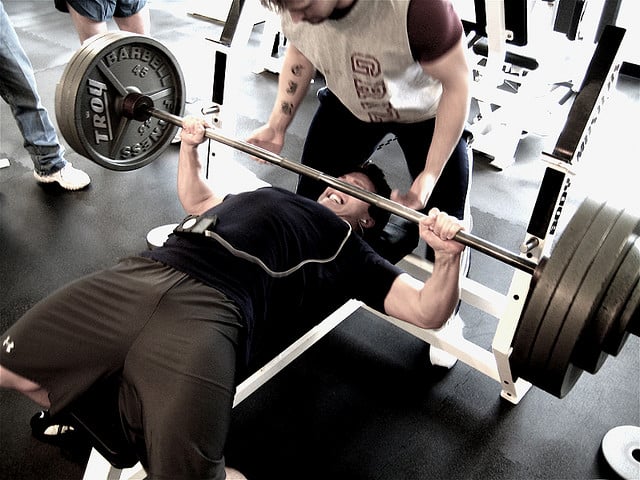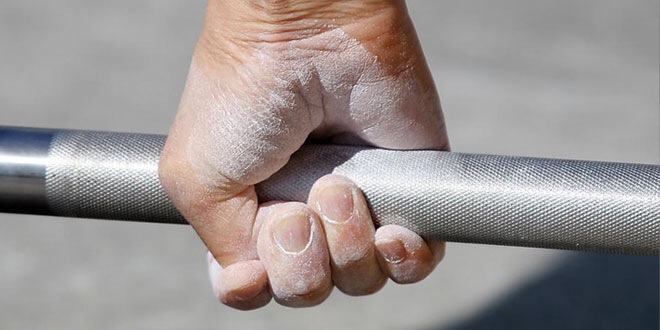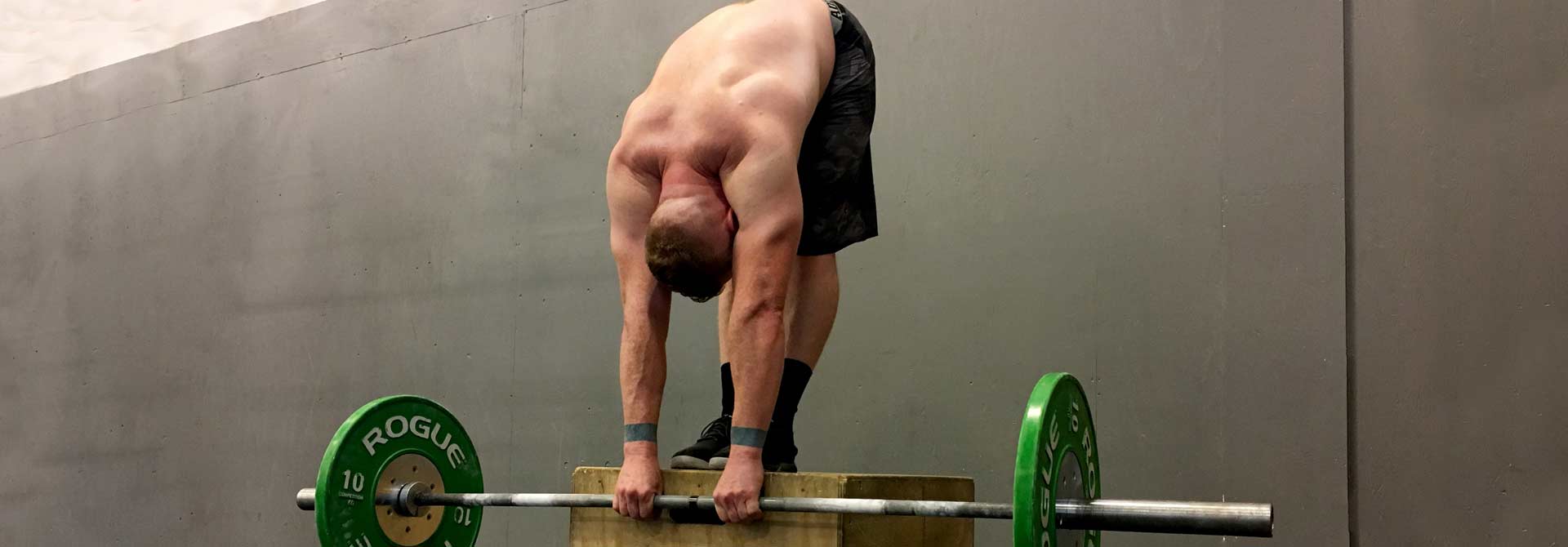Shoulder and rotator cuff pain is the most frequent upper body pain a powerlifter can encounter, matched by lower back pain and knee pain for the torso and lower body respectively. Whether you’re currently recovering from a shoulder strain or just want to avoid creating or aggravating a shoulder problem, it definitely pays to learn how to bench press without shoulder pain.
Wear-and-tear injuries can be the result of poor recovery, a high volume of training, underlying stress factors, a history of old injuries, and other factors. In order to understand why shoulder problems are so common in the bench press, we need to go over a few basic details:
- The anterior portion of your deltoid muscle (shoulder muscle) is a prime mover in the bench press, alongside the triceps and the pecs. The bottom position of the bench press generally forces the deltoid to stretch more than it would even in the bottom position of an overhead press. This doesn’t mean you should avoid a full ROM bench press – instead, you should understand that shoulder health is imperative for a consistent bench press.
- Loose shoulder blades (not properly retracted) during the bench press can cause anterior humeral glide, wherein the shoulder gets dumped forward causing impingement, rotator cuff problems due to improper loading or internal rotation of the shoulder, and lots of pain.
- Excessively abducted elbows can also damage and inflame the AC joint, between your acromion and collarbone.
- Excessive strain on the shoulders during the bench press can also lead to partial or full tearing of the labrum, which is a thin rim of tissue covering the head of the humerus.
- Bench pressing more often than your body can handle, or bench pressing a lot without a proportional amount of pulling exercises and bicep curls, can cause inflammation in the shoulder socket and elbow, or at the base of the biceps (where it originates on the shoulder).
To bench press without shoulder pain, we need to do two things: address the pain and address the bench press.
NOTE: If your pain is severe and your mobility is limited, go visit a medical professional. Listen carefully to your doctor and ask about rehabilitation options. This article is not meant to be a guide for self-diagnosing shoulder pain – it is simply meant for readers who have dealt with pain and want to learn how to bench press without shoulder pain.
Take a Break
If your pain is minor and your injury is recent, then the first thing you should do is take a break from bench pressing. That doesn’t mean you should take a break from pressing in general. We will continue to train the press, but differently. Some forms of shoulder pain as a result of bench pressing are very simply a matter of overuse – resting will give your shoulders the chance to heal and avoid becoming chronically inflamed, or seriously injured.
If your pain is sharper, originating at a point or occurring during specific movements and/or exercises, it could be some form of impingement or a strained ligament. Minor tears aren’t too bad in the long-term, provided they serve as an effective warning for you to be more mindful of your form in any pressing and pulling exercise. Total tears, on the other hand, can only be treated surgically. If your pain is persistent and overwhelming, please go see a professional.
Two to three weeks off the bench is often enough to begin reincorporating the movement to a specific degree. This does NOT mean going right back to a normal pressing volume, or even the competition bench press. If the pain is minor, start by reducing your pressing volume by about half. If it’s more severe, take a longer break. While you’re unable to bench press, you can start using other exercises to rehabilitate your shoulder, including specific shoulder exercises and pressing alternatives like the pushup.
Learn to Bench Press Properly
The biggest piece of advice I would give any beginning or intermediate lifter with poor bench press form is to learn how to properly engage your entire body to press effectively. The second biggest piece of advice would be learning how to give yourself a handoff if need be, and to learn to ask someone for handoffs 80% of the time.
First, the setup. The critical thing about bench press form is that we want to take our scapulae out of the equation and minimize the mobility of the shoulder blades. This will NOT work if your bench is slippery. Use a yoga mat or a resistance band wrapped lengthwise over the bench to keep yourself from sliding.
Then, you want to get a good hold with your feet. Bring them back closer to where your butt would be on the bench, so you begin to get a good stretch through the hips and quads. Then, retract and depress your shoulders. If you’re uncomfortable depressing your shoulders, you can retract and elevate them.
Play around with it, as long as you’re squeezing your shoulder blades together as much as you can. Lean back onto the bench and press with your feet through into your shoulders, so you’re pushing them into the bench. Keep that pressure. The idea here is to use your legs to keep those shoulders pressed into the bench, so they’re forcibly retracted throughout the movement.
Grip width, foot stance, and level of arching will depend on factors such as limb length and mobility. You want an arch as big as possible, and a grip as wide as possible. This is especially important if you’ve got really long arms.
The order in which you set up is purely a personal preference. I press through my legs and glutes and stay in a glute bridge until after the handoff, at which point I slowly lower my glutes onto the bench and start the bar descent as soon as they touch. It helps me stay as tight as possible. You might not like doing it that way, though. As long as you stay tight and continue to press through your legs to keep that tension and that arch, you’re good.
Do More Pushups
The usefulness of the pushup extends far beyond its reputation as the world’s most basic calisthenics exercise. Pushups allow for complete scapular freedom, which is why we should make use of them to train scapular protraction.
This is the opposite of scapular retraction. When in the plank position after each rep, make sure to spread your shoulder blades apart and try to push yourself as far away from the ground as possible without breaking form. This trains muscles within the torso that help with both protraction and retraction (the serratus), and it will help keep those shoulders healthy. It also helps fix scapular winging. Dips and overhead pressing also help train the serratus and stabilize the scapulae.
When taking a break from the bench press, I recommend that you spend your first two weeks doing pushups instead. Do them twice to thrice a week depending on tolerance and move on from regular pushups to instability pushups as soon as the pain subsides. You can use rings, suspension trainers, or a Bosu ball to do instability pushups. Doing pushups with your hands on resistance bands attached to parallel bars works well too.
Do More Rows
For every set of pressing, you should be doing one set of pulling. Vary your pulling exercises and do unilateral movements (single-arm cable rows and dumbbell rows), vertical pulls (pull-ups and lat pulldowns) as well as horizontal pulls (high-rep chest-supported rows, T-rows, Yates rows, and so on).
Shoulder injuries are more likely to happen when the musculature in and around the shoulder develops in strength in an unbalanced way. By rowing as often as you press, you’re keeping your shoulders happy and you can avoid rolled shoulders by training not only the chest but also the upper back.
Practice Scapular Retraction
If you find it uncomfortable or difficult to adequately retract your shoulder blades, it helps to practice off the bench, with resistance. Cables, bands, light dumbbells, or even a pull-up bar (if you’re light enough) can help you learn to retract your shoulder blades. Either hang off the bar or do unilateral “scapular” pulls, pulling your shoulder back without flexing the elbow or allowing downward rotation of the shoulder (i.e. pulling your arm down to your side).
When doing pulling exercises, focus on bringing your elbows together behind your back as much as you can, which both squeezes your lats harder than usual and helps you retract your shoulder blades. Keep your shoulders slightly externally rotated as you do so, to avoid rounding them forward during the pull. Choose a lighter weight when doing cable or dumbbell rows, so you can hold the weight at the top of each rep and feel the retraction.
Once you’re back to practicing retraction on the bench, remember to use a grippy bench, start with a lighter weight, and learn to press explosively while staying tight in the upper back. It’s very awkward for beginners, but you’ll get the hang of it with some practice.
Strengthen Your Shoulders
I’ve written about the importance of building shoulder strength and size before, and it still stands – stronger shoulders, as with other body parts, are less likely to get hurt. When training your shoulders, focus on exercises that target each deltoid head (the medial, the anterior, and the posterior), as well as light exercises of internal and external rotation.
I personally don’t like dumbbell exercises for internal or external rotation. Instead, use a light resistance band or a cable machine to do:
- Face pulls. You usually do these on a cable machine, and the idea is to pull your hands back behind your elbows so you’re focusing on external shoulder rotation.
- Banded pull aparts. These are more of a rear delt exercise. Just grab a resistance band on both ends and pull it apart. Try to keep your shoulders protracted and focus on contracting your rear delts
- Scapular wall slides. A great mobility exercise, these have you standing with your back against the wall, and with your forearms flush to the wall, elbows and wrists touching the wall. Slide up and down as though you were moving through the full range of motion of an overhead press. If you can’t do this while retaining contact with the wall, you’ve got external rotation issues.
- Unilateral rotation. Grab a band or cable and do both internal and external rotation with one arm, keeping your elbow close to your torso and focusing solely on the shoulder.
Light weights are your friend here. I usually go for sets of 12-20 on any deltoid or rotation exercise, focusing on form and contraction rather than load, with the exception of a heavy overhead press, which can also be a great accessory to build both strong shoulders and strong serratus muscles.
Switch to Floor Presses & Board Presses
Once you’ve incorporated more pulling and shoulder work, as well as a bunch of pushups, it’s time to return to the bench press. Start with a floor press to limit the range of motion and limit the likelihood of aggravating anything in your shoulder joint. Once you move onto the bench, use boards to slowly increase the range of motion of your press, and keep your bench-pressing frequency at 50-70% of what it was before you got injured. You can also use Spoto presses to train through a specific range of motion and stay well within your pain threshold.
Learning to bench press without shoulder pain is well worth it. The shoulder is fickle, and once it’s injured, it can often become a recurring problem. If you’re not interested in competing at all, you can supplant the bench press with the floor press entirely. The reduced range of motion will put less stress on your shoulders, provided you aren’t abducting the elbows too much, and you continue to retract your scapulae.




